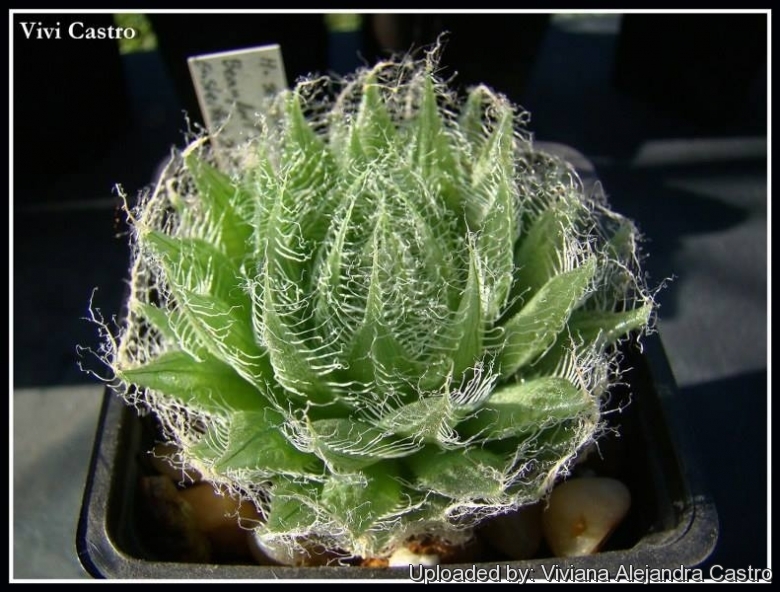




Your support is critical to our success.
Accepted Scientific Name: Haworthia semiviva (Poelln.) M.B.Bayer
Haworthia Handb. 153 (1976)

Origin: Beaufort West Exisleilan, Western Cape, South Africa.
Origin and Habitat: Fraserburg, Sutherland and Williston districts, Northern and Western Cape, South Africa
Habitat and ecology: Haworthia semivivaSN|16955]]SN|16952]] is a contracted and reduced succulents that grow embedded on shallow soil and in rock crevices, in very small and isolated populations in the Karoo, desert region of South Africa. Some of the high temperatures are recorded in the area where this species occurs. It is not surprising that Haworthia semivivaSN|16952]]SN|16952]], which has the incurved, setaceous form of the 'arachnoidea-decipiens' type, has developed the protective 'die back' leaf character seen also in the allied but non-setose Haworthia lockwoodiiSN|16952]]SN|16955]] near Laingsburg. In many other embedded plant forms, including Bulbine mesembryanthemoidesSN|22628]]SN|22628]], haworthias and many species of Opthalmophyllum and Lithops, light reaches internal chloroplasts in the buried leaf through windows of unpigmented cells on the exposed leaf tips. Small succulents resemble the soil, stones or dung of their habitats, or the shadows and woody stems of the shrubs that shelter them. Individuals that escape predation may be remarkably long-lived, up to 95 years in the case of Lithops plants.
Synonyms:
- Haworthia semiviva (Poelln.) M.B.Bayer
- Haworthia arachnoidea var. semiviva (Poelln.) Halda
- Haworthia bolusii var. semiviva Poelln.
AFRIKAANS (Afrikaans): Papierrosie
CHINESE (中文): 赛米维亚
Description: Haworthia semivivaSN|16990]]SN|16952]] is a beautiful Harworthia, having lovely pale green rosettes with ruffled, silky, edges. The drying of the leaf tips is natural in this species. It provides a protection from the elements in its natural habitat. When in the dry state H. semiviva look more dead than alive.
Rosette: Stemless, 5-8 cm across, nearly always solitary, rarely proliferating.
Leaves: 30-40, broadly ovate, up to 60 mm long, 15 mm wide, thin, pale green, incurred, the tip translucent and flattened, drying up from the tips in the resting period. Nargin and keel with long translucent bristles.
Inflorescences: 20-30 cm tall usually unbranched, 30-35-flowered. The flowers are white with green venation, broad and flat across the upper base of the tube.
Similar species: Haworthia aristataSN|16952]]SN|16990]] may key out here. It differs in the margin having relatively sparse teeth and the terminal bristle being toothed.
Bibliography: Major references and further lectures
1) Doreen Court “Succulent Flora of Southern Africa” CRC Press, 01/Jun/2000
2) Urs Eggli “Illustrated Handbook of Succulent Plants: Monocotyledons” Springer, 2001
3) Charles L. Scott “The genus Haworthia (Liliaceae): a taxonomic revision” Aloe Books, 1985
4) Stuart Max Walters “The European Garden Flora: Pteridophyta, Gymbospermae, Angiospermae-Monocotyledons” Cambridge University Press, 1984
5) M. B. Bayer “The new Haworthia handbook” National Botanic Gardens of South Africa, 1982
6) John Pilbeam “Haworthia and Astroloba: A Collector's Guide” B. T. Batsford Limited, 1983
7) Bruce Bayer “Haworthia revisited: a revision of the genus” Umdaus Press, 1999
8) Ernst Van Jaarsveld, Ben-Erik Van Wyk, Gideon Smith “Succulents of South Africa: A Guide to the Regional Diversity” Tafelberg Publishers, Limited, 01/Jul/2000
9) R. M. Cowling, D. M. Richardson, S. M. Pierce "Vegetation of Southern Africa" Cambridge University Press, 01/Apr/2004
10) Germishuizen, G. & Meyer, N.L. (eds.). “Plants of Southern Africa: an annotated checklist” Strelitzia 14.: i-vi, 1-1231. National Botanical Institute, Pretoria. 2003
11) von Poellnitz, K. "Original description of Haworthia semiviva." 1976
12) Karl von Poellnitz "Neue Formen der Gattung Haworthia Duval” In: Repertorium novarum specierum regni vegetabilis. 44:5–10, 135 1938
13) Martin Bruce Bayer “Haworthia Handbook.” Kirstenbosch page 153 1976
17) “Haworthia semiviva” in: Cactus and Succulent Journal (U.S.) 48: 256 1976
Cultivation and Propagation: Be carefully with watering - you can very easy lost the plant when water gets (and stay there for a while) into middle of the rosette as moisture captured between leaves can cause the plant to rot. Water only in winter with sparse watering in spring and autumn only. Some authorities say that the plants should never be watered from above. Potted plants should probably be protected from harsh afternoon sun. Repot every two years with well-draining potting mix.
Propagation: It is not known to produce offsets so propagation is usually done by seeds. Leaf cuttings or coring must also be used to try to reproduce this plant. The leaf-cuttings can dry out if kept under low humidity and rot if kept in humid situations. Coring involves cutting out the center of the plant to produce offsets. All these techniques are very disfiguring to the plant, of course.
| Your Actions | |
|---|---|
| Back to Haworthia index | |
| Back to Aloaceae index | |
 |
Back to Succulents Encyclopedia index |
Privacy stantement - Terms and conditions - How to cite - About us - Feedback - Donate



